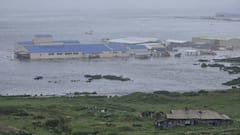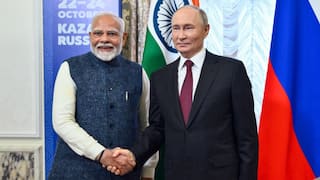Explained: What Is Minerals Security Partnership? Which Countries Are Part Of It And Why?
The Minerals Security Partnership was announced in June 2022, with an aim to strengthen critical mineral supply chains. Also know what are critical minerals, and why they are so important.

The Minerals Security Partnership (MSP) is an ambitious new initiative to bolster critical mineral supply chains, announced by the United States (US) and key partner countries in June 2022. During the Prospectors and Developers Association of Canada convention in Toronto, the largest mining event in the world, the US and key partner countries made the announcement.
However, India is not a part of this partnership.
According to a statement released by the US Department of State, the goal of the MSP is to ensure that critical minerals are produced, processed, and recycled in a manner that supports the abilities of countries to realise the full economic development benefit of their geological grants.
Critical minerals are essential for clean energy and other technologies, and the demand for these minerals is projected to expand significantly in the future.
The partnership will help catalyse investment from governments and the private sector for strategic opportunities that adhere to the highest environmental, social, and governance standards, across the full value chain, the statement said.
Which Countries Are Part Of The Mineral Security Partnership?
Australia, Canada, Finland, France, Germany, Japan, the Republic of Korea, Sweden, the United Kingdom, the United States, and the European Commission are part of the partnership. The MSP partners are committed to building robust, responsible critical mineral supply chains to support economic prosperity and climate objectives, the statement said.
India is not a part of the 11-member group committed to strengthen critical mineral supply chains, and reduce dependency on China.
What Are Critical Minerals?
Critical minerals are mineral resources that are essential to the economy, and whose supply may be disrupted, and the 'criticality' of which changes with time as supply and society's needs change.
Critical minerals such as copper, lithium, nickel, cobalt and rare earth minerals are essential components in the rapidly growing clean energy technologies such as wind turbines and electric vehicles. As clean energy transitions gather pace, the demand for these minerals will grow quickly, according to the International Energy Agency.
A critical mineral is a metallic or non-metallic element that is essential for the functioning of modern technologies, economics, or national security, has a supply chain at risk of disruption, and is used to manufacture advanced technologies, according to Geoscience Australia, an agency of the Australian government carrying out geoscientific research.
The advanced technologies which can be manufactured using critical minerals include mobile phones, computers, tablets, semiconductors, fibre-optic cables, and defence, aerospace and medical applications.
Critical minerals are also used in low-emission technologies such as electric vehicles, wind turbines, solar panels, and rechargeable batteries, and could be used for common products such as stainless steel and electronics.
Many critical minerals, including rare earth minerals and metals such as lithium, gallium, tellurium, and indium are central to high-tech sectors, according to the American Geosciences Institute.
Based on the relative importance of particular minerals to the industrial needs of a country, and the strategic assessment of supply risks, individual countries develop their own lists of critical minerals.
The 11-member MSP group will aim to bolster the supply chains of critical minerals such as cobalt, lithium, nickel, gallium, and 17 Rare Earth minerals.
What Are The Risks To Critical Mineral Supply Chains?
When production of critical minerals is dominated by individual countries or companies, critical mineral supply chains might be at risk, limiting availability. Market immaturity, social unrest, political decisions, mine accidents, natural disasters, geological scarcity, war, and pandemics are other factors which pose a risk to critical mineral supply chains.
What Is The Role Of Critical Minerals In Clean Energy Transitions? What Are The Challenges?
The critical minerals used in electric vehicles to improve battery performance include cobalt, manganese, and graphite. Permanent magnets used in wind turbines and electric vehicle motors require rare earth minerals. A huge amount of copper and aluminium is needed for the construction of electricity networks. Copper is the cornerstone of all electricity-related technologies, according to the International Energy Agency.
A clean energy technology-powered energy system is different from a system fuelled by traditional hydrocarbon resources. A large number of minerals are required to build solar photovoltaic plants, wind farms, and electric vehicles.
According to the International Energy Agency, an electric car requires six times the mineral inputs of a conventional car, and a wind plant requires nine times more mineral resources than a gas-fired plant.
The average amount of minerals required for a new unit of power generation capacity has increased by 50 per cent since 2010.
Countries are accelerating their efforts to reduce emissions, and hence, must make sure that energy systems remain resilient and secure. Since the importance of critical minerals is rising in a decarbonising system, it has become essential for energy policy makers to expand their horizons.
Clean-energy technologies are becoming the fastest-growing segment of demand as energy transitions gather pace.
According to the International Energy Agency, critical minerals' share of total demand, in a scenario that meets the Paris Agreement goals, rises significantly over the next two decades to over 40 per cent for copper and rare earth minerals, 60 to 70 per cent for nickel and cobalt, and about 90 per cent for lithium. Electric vehicles and battery storage have become the largest consumer of lithium, displacing consumer electronics. By 2040, they are set to displace stainless steel to become the largest end user of nickel.
What Are Rare Earth Minerals?
Rare earth minerals are a set of seventeen metallic elements which include the scandium, yttrium, and the fifteen lanthanides on the periodic table.
According to the American Geosciences Institute, rare earth minerals are an essential part of many high-tech devices. These minerals are necessary components of more than 200 products across a wide range of applications, especially high-tech consumer products such as computer hard drives, cellular telephones, flat-screen monitors and televisions, and electric and hybrid vehicles.
According to the United States Geological Survey, the significant defence applications of rare earth minerals include electronic displays, guidance systems, laser, and radar and sonar systems.
The amount of rare earth minerals used in a product may not be a significant part of that commodity by weight, value of volume, but can be necessary for the device to function. For instance, only a small amount of rare earth minerals is used in magnets, but the spindle motors and voice coils of desktops and laptops would not function without those minerals.
Mineral Security Partnership Aims To Decrease Dependency On China For Critical Minerals
China is responsible for around half of the worldwide production of rare earth minerals.
According to the US Geological Survey, 38 per cent of world production of rare earth minerals in 1993 was in China, 33 per cent in the US, 12 per cent in Australia, and five per cent each in Malaysia and India.
However, China accounted for more than 90 per cent of the world production of rare earth minerals in 2008. By 2011, China accounted for 97 per cent of world production.
Since 1990, supplies of rare earth minerals became an issue because the Chinese government began to change the amount of rare earth minerals it allows to be produced and exported, and also started limiting the number of Chinese and Sino-foreign joint venture companies that could export rare earth minerals from China.
The MSP is aimed at reducing dependency on China for rare earth minerals, according to media reports.
In 2019, the Democratic Republic of China (DRC) and the People's Republic of China (China) were responsible for about 70 per cent and 60 per cent of global production of cobalt and rare earth minerals z respectively.
China's share of refining is 50 to 70 per cent of lithium and cobalt, around 35 per cent for nickel, and nearly 90 per cent for rare earth minerals.
Chinese companies have made investments in overseas assets in Chile, Indonesia, and Australia. According to the International Energy Agency, complex supply chains could increase the risks that might arise from trade restrictions or other developments in major producing countries.
China is one of the major producing regions subject to extreme heat or flooding. This poses greater challenges in ensuring reliable and sustainable supplies.
Both the MSP and the Australia-India Critical Minerals Investment Partnership are aimed at unlocking the benefits of the critical minerals sector.
What Is The Australia-India Critical Minerals Investment Partnership?
The Australia-India Critical Minerals Investment Partnership is an investment partnership that is set to unlock mutual benefits for India and Australia from Australia’s world-leading critical minerals sector. In March 2022, the Australian Government allocated $5.8 million to the three-year Australia-India Critical Minerals Investment Partnership.
In a statement released by the Department of Industry, Science, and Resources, a department of the Australian Government, Keith Pitt, the Minister for Resources and Water, said that Australia and India are natural partners sharing mutual strategic and economic priorities and the partnership will support further Indian investment in Australian critical minerals projects. He added that the partnership is the “first of its kind”, and that the combined capabilities of the two countries will take on the challenge of resourcing the emerging technologies used in sectors such as defence, automotive, aerospace, telecommunications, renewable energy and agritech.
Pitt also said that Australia and India will work together closely to identify potential critical minerals investment opportunities.
According to a statement released by the Australian Trade and Investment Commission, Australian companies and institutions will partner with India to supply critical minerals, export services and technology to process, refine, recover, and recycle critical minerals, help with mineral exploration in India, carry out joint research projects, and support India’s mining-related environmental management.
On July 3, 2022, the Union Minister of Parliamentary Affairs, Coal and Mines, Pralhad Joshi, and four other senior Indian government representatives visited Australia as part of a six-day tour to strengthen bilateral relations between the two countries. As part of its larger mission to transition to clean sources of energy, India is set to move a step closer to realising its ambition to develop secure, robust, and commercially viable strategic critical minerals, a statement released by the Ministry of Mines, Government of India, said.
Joshi visited mineral-rich sites of Tianqi Lithium Kwinana processing facility, Greenbushes Mine, CSIRO Australian Resources Research Centre, and Western Australian Geological Survey Core Library in Australia, during the visit.
According to the statement, the Australia-India Critical Minerals Investment Partnership envisages joint investment for viable lithium and cobalt projects in Australia. These steps are critical for India’s transition towards clean energy ambitions, and will complement India’s mineral security for electric vehicle initiatives and other sectors that make use of critical minerals.
The delegation visit to Australia marked the first milestone in the Australia-India Critical Minerals Investment Partnership.
What Are The Eight Priority Critical Minerals?
There are eight critical minerals that matter the most to Australia and India, according to the Australian Government. Based on their end-use industries, the minerals are divided into three groups, namely traditional, sunrise, and mixed use.
Titanium and vanadium are the traditional minerals, lithium is the sunrise mineral, and cobalt, nickel, graphite, light rare earth minerals, and heavy rare earth minerals are the mixed use minerals.







































